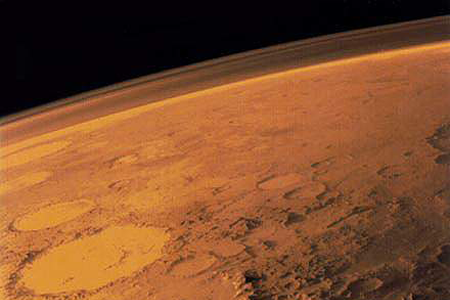One Mineral Could Tell Exactly When Mars Was Covered In Water. Science Get!

At this point we know that Mars has water. Had water. Maybe has water, definitely had water. One mineral we’ve retrieved from the Angry God could held the key to figuring out exactly when the Red One was covered in water.
io9:
That tool is the mineral jarosite, which was discovered on the Martian surface by the Opportunity rover back in 2004. Mainly composed of potassium and iron, jarosite has one very special property: it can only form in water on a planetary surface. This has been taken as some of the best indirect evidence that a substantial amount of water once existed on Mars.
Researchers at Syracuse University hoped to put jarosite to further use beyond simply suggesting the existence of water. They hoped to develop a way to determine from these mineral samples precisely when the water existed, and in what surface conditions it existed. They have found that the noble gas argon accumulates in jarosite over time, and this fact can be used to reveal much about how the planet once looked.
Team member Joseph Kula explains:
“Our experiments indicate that over billion-year timescales and at surface temperatures of 20 degrees Celsius (68 degrees Fahrenheit) or colder, jarosite will preserve the amount of argon that has accumulated since the crystal formed, which simply means that jarosite is a good marker for measuring the amount of time that has passed since water was present on Mars.”
Jarosite is particularly intriguing to researchers because it can reveal just when Mars began to lose its water, which by extension means we could work out how long watery conditions persisted on the planet. If it turns out Mars was watery for a long period of geological time, that strengthens the case that life once evolved on Mars.
Fellow researcher Suzanne Baldwin adds:
“Jarosite requires water for its formation, but dry conditions for its preservation. We’d like to know when water formed on the surface of Mars and how long it was there. Studying jarosite may help answer some of these questions. Our results suggest that 4 billion-year-old jarosite will preserve its argon and, along with it, a record of the climate conditions that existed at the time it formed.”
To make sure these results are as accurate as possible, the researcher are also working with jarosite samples from Wyoming that formed in the last 50 million years. These should be helpful in calibrating the “argon clock” that the researchers hope to use to explore Mars’s past. This research is really only just beginning, but the key tool of exploration is in place. Now we just need to see what it can reveal of Mars’s past, which may well include both water and life.
Oh, you know. Billion-year timescales and the such.



